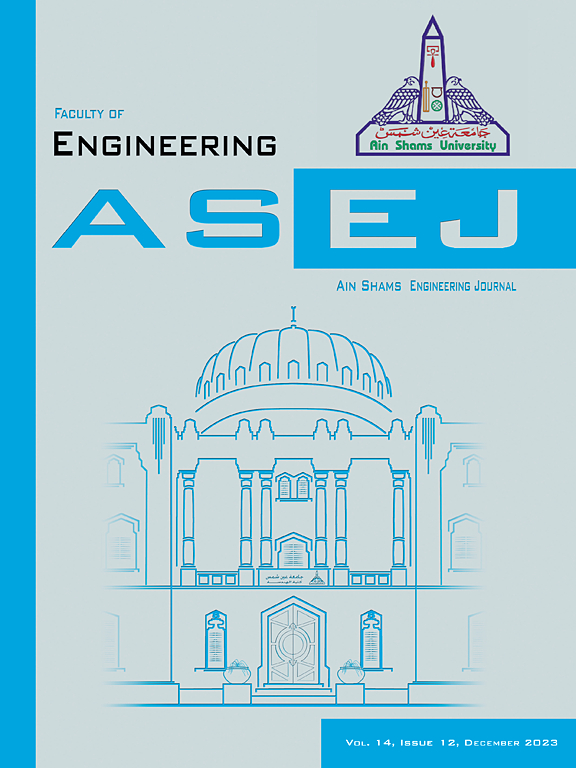Comparative study of oblique stagnation point flow of MWCNT-Ag/blood and MWCNT/blood nanofluids due to shrinking surface
IF 6
2区 工程技术
Q1 ENGINEERING, MULTIDISCIPLINARY
引用次数: 0
Abstract
Hybrid nanofluids improved the thermal characteristics and stability features of various applications including thermal efficiency systems, solar collectors, energy production, nuclear processes, and heat transfer properties. Motivated by above mentioned applications of hybrid nanofluids, the primary aim is to explore the heat transfer analysis through a comparative study of (MWCNT-Ag/blood) hybrid nanofluid and (MWCNT /blood) nanofluid near an oblique stagnation point flow with the impact of non-linear thermal radiation, variable thermal conductivity and non-uniform heat generation/absorption across a shrinking surface. The influence of suction, convective boundary condition are also under consideration. The governing flow problem is reformed into non-linear ODEs employing appropriate similarity variables. A suitable technique bvp4c built-in MATLAB function used for numerical solutions. A comprehensive analysis of distinct influential fluid factors against drag friction, Nusselt number, flow, and thermal transportation are examined graphically. The outcome shows that friction drag increases with the increment in suction parameter for both hybrid and monofluids for stable branch solutions. Furthermore, heat transportation rate rises with the addition of variable thermal conductivity and radiation factors for hybrid nanofluid and monofluid. It also observed that hybrid nanofluid boosted rapidly compared to a naonofluid, representing an improvement in thermal characteristics is more stable for hybrid nanofluid than monofluid. Additionally, increasing the temperature ratio factors shows an upsurge in thermal distribution profile.
MWCNT- ag /血纳米流体与MWCNT/血纳米流体由于表面收缩导致的斜驻点流动的比较研究
混合纳米流体改善了各种应用的热特性和稳定性,包括热效率系统、太阳能集热器、能源生产、核过程和传热特性。基于上述混合纳米流体的应用,本研究的主要目的是通过比较研究(MWCNT- ag /blood)混合纳米流体和(MWCNT /blood)纳米流体在倾斜滞止点附近的流动,在非线性热辐射、可变导热率和非均匀产热/吸收的影响下,在缩小的表面上进行传热分析。同时考虑了吸力、对流边界条件的影响。采用适当的相似变量将控制流问题转化为非线性微分方程。合适的技术bvp4c内置MATLAB函数,用于数值求解。综合分析了对阻力摩擦、努塞尔数、流动和热输运的不同影响流体因素。结果表明,对于稳定分支溶液,无论是混合流体还是单流体,摩擦阻力都随着吸力参数的增加而增加。此外,混合纳米流体和单流体的热传递率随热导率和辐射因子的变化而增加。它还观察到,与纳米流体相比,混合纳米流体的速度更快,这表明混合纳米流体的热特性比单流体更稳定。此外,温度比因子的增加表明热分布曲线的上升。
本文章由计算机程序翻译,如有差异,请以英文原文为准。
求助全文
约1分钟内获得全文
求助全文
来源期刊

Ain Shams Engineering Journal
Engineering-General Engineering
CiteScore
10.80
自引率
13.30%
发文量
441
审稿时长
49 weeks
期刊介绍:
in Shams Engineering Journal is an international journal devoted to publication of peer reviewed original high-quality research papers and review papers in both traditional topics and those of emerging science and technology. Areas of both theoretical and fundamental interest as well as those concerning industrial applications, emerging instrumental techniques and those which have some practical application to an aspect of human endeavor, such as the preservation of the environment, health, waste disposal are welcome. The overall focus is on original and rigorous scientific research results which have generic significance.
Ain Shams Engineering Journal focuses upon aspects of mechanical engineering, electrical engineering, civil engineering, chemical engineering, petroleum engineering, environmental engineering, architectural and urban planning engineering. Papers in which knowledge from other disciplines is integrated with engineering are especially welcome like nanotechnology, material sciences, and computational methods as well as applied basic sciences: engineering mathematics, physics and chemistry.
 求助内容:
求助内容: 应助结果提醒方式:
应助结果提醒方式:


